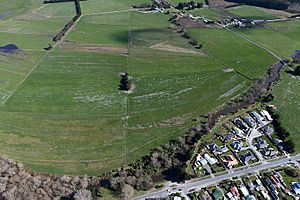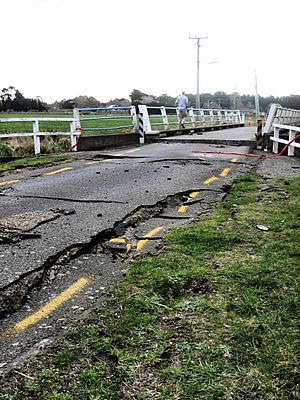Spencerville, New Zealand facts for kids
Quick facts for kids
Spencerville
|
|
|---|---|

Spencerville and the Styx River
|
|
| Country | New Zealand |
| Region | Canterbury |
| Territorial authority | Christchurch City |
| Ward | Coastal |
| Community | Waitai Coastal-Burwood-Linwood |
| Electorates |
|
| Area | |
| • Total | 0.37 km2 (0.14 sq mi) |
| Population
(June 2023)
|
|
| • Total | 570 |
| • Density | 1,540/km2 (3,990/sq mi) |
Spencerville is a small town located on the east coast of Canterbury, New Zealand. It sits just north of the city of Christchurch. Spencerville is known for its natural beauty and outdoor activities.
The town is next to Bottle Lake Forest and has a large park. There is also a big camping ground, covering 80 hectares. These places, along with local wetlands and an animal and bird park, make Spencerville a popular spot for people from Christchurch to go camping and enjoy nature.
After the 2011 Christchurch earthquake, the New Zealand Government made new rules for building in Spencerville. The land was called Technical Category T3. This means that builders and developers must follow stricter rules to make sure buildings are safe and strong.
Contents
Who Lives in Spencerville?
This section tells us about the people who live in Spencerville. It covers things like how many people there are, their ages, and their backgrounds.
Spencerville is considered a rural settlement by Statistics New Zealand. In 2018, about 513 people lived here. The town covers a small area of 0.37 square kilometers.
Population Changes Over Time
The number of people living in Spencerville has changed over the years.
- In 2006, there were 576 people.
- By 2013, the population went down to 507.
- In 2018, it went up slightly to 513 people.
People and Households
In 2018, there were 165 households in Spencerville. A household is a group of people living together in one home. There were slightly more males (264) than females (255).
Age Groups in Spencerville
The population of Spencerville includes people of all ages:
- About 21.6% of residents were under 15 years old.
- Around 21.1% were aged 15 to 29.
- The largest group, about 48.5%, were aged 30 to 64.
- About 8.8% of people were 65 years old or older.
Different Backgrounds and Cultures
Spencerville is home to people from various backgrounds:
- Most residents, about 91.2%, are of European/Pākehā descent.
- About 13.5% identify as Māori.
- Smaller groups include Pasifika (4.1%) and Asian (4.1%).
- Some people also identify with other ethnicities.
Beliefs and Religions
When asked about their religious beliefs in 2018:
- About 56.7% of people said they had no religion.
- Around 34.5% identified as Christian.
- Small numbers of people followed Hinduism (0.6%), Buddhism (0.6%), or other religions (2.3%).
Education and Jobs
Many adults in Spencerville have good education:
- About 22.4% of people aged 15 and older had a university degree or higher.
- Around 14.9% did not have formal qualifications.
When it comes to jobs:
- About 53.0% of people aged 15 and older worked full-time.
- Around 21.6% worked part-time.
- About 3.7% were unemployed.


